Paper Menu >>
Journal Menu >>
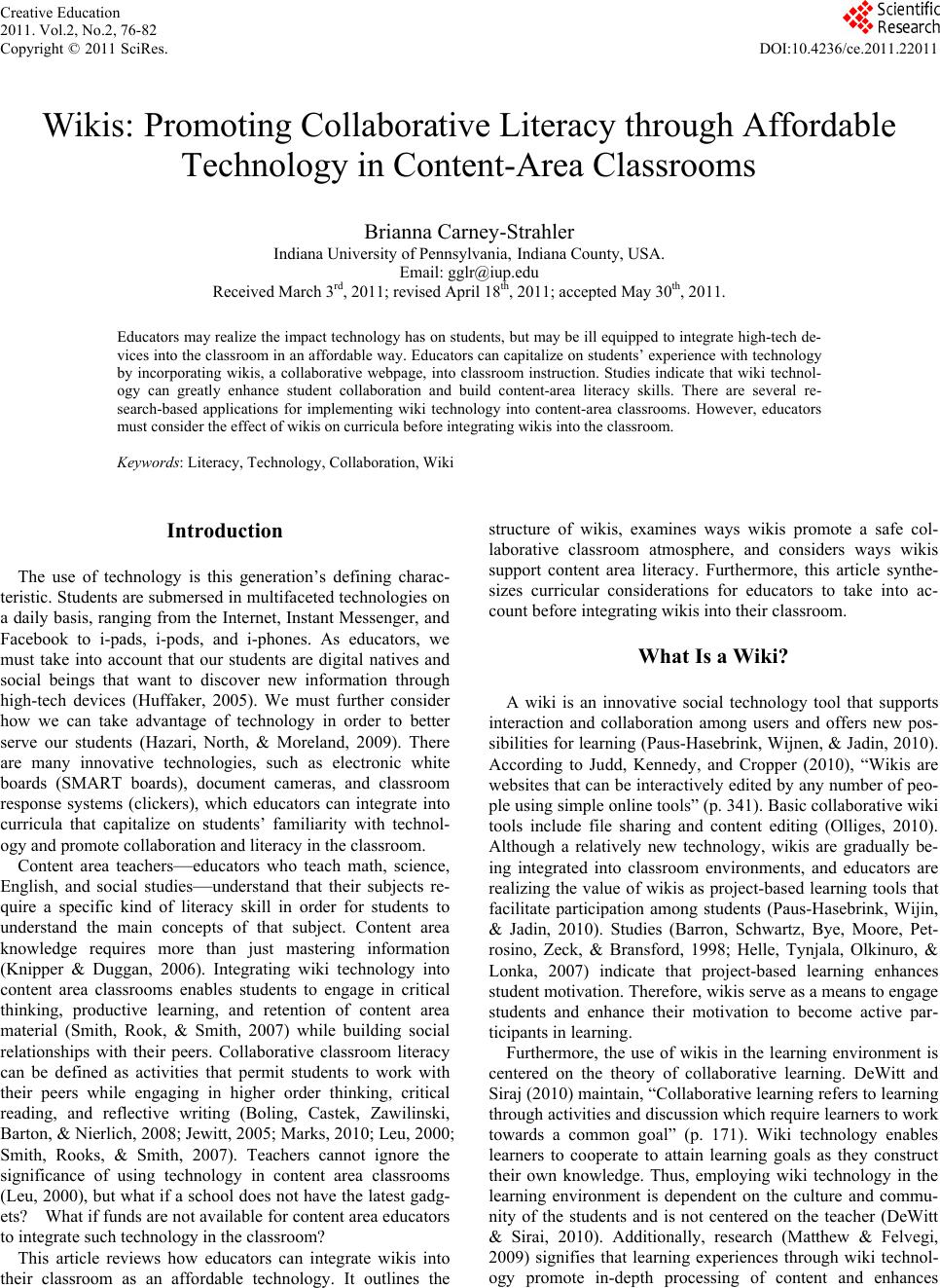 Creative Education 2011. Vol.2, No.2, 76-82 Copyright © 2011 SciRes. DOI:10.4236/ce.2011.22011 Wikis: Promoting Collaborative Literacy through Affordable Technology in Content-Area Classrooms Brianna Carney-Strahler Indiana University of Pennsylvania, Indiana County, USA. Email: gglr@iup.edu Received March 3rd, 2011; revised April 18th, 2011; accepted May 30th, 2011. Educators may realize the impact technology has on students, but may be ill equipped to integrate high-tech de- vices into the classroom in an affordable way. Educators can capitalize on students’ experience with technology by incorporating wikis, a collaborative webpage, into classroom instruction. Studies indicate that wiki technol- ogy can greatly enhance student collaboration and build content-area literacy skills. There are several re- search-based applications for implementing wiki technology into content-area classrooms. However, educators must consider the effect of wikis on curricula before integrating wikis into the clas s room. Keywords: Literacy , Technology, Collaboration, Wiki Introduction The use of technology is this generation’s defining charac- teristic. Students are submersed in multifaceted technologies on a daily basis, ranging from the Internet, Instant Messenger, and Facebook to i-pads, i-pods, and i-phones. As educators, we must take into account that our students are digital natives and social beings that want to discover new information through high-tech devices (Huffaker, 2005). We must further consider how we can take advantage of technology in order to better serve our students (Hazari, North, & Moreland, 2009). There are many innovative technologies, such as electronic white boards (SMART boards), document cameras, and classroom response systems (clickers), which educators can integrate into curricula that capitalize on students’ familiarity with technol- ogy and promote collaboration and literacy in the classroom. Content area teachers—educators who teach math, science, English, and social studies—understand that their subjects re- quire a specific kind of literacy skill in order for students to understand the main concepts of that subject. Content area knowledge requires more than just mastering information (Knipper & Duggan, 2006). Integrating wiki technology into content area classrooms enables students to engage in critical thinking, productive learning, and retention of content area material (Smith, Rook, & Smith, 2007) while building social relationships with their peers. Collaborative classroom literacy can be defined as activities that permit students to work with their peers while engaging in higher order thinking, critical reading, and reflective writing (Boling, Castek, Zawilinski, Barton, & Nierlich, 2008; Jewitt, 2005; Marks, 2010; Leu, 2000; Smith, Rooks, & Smith, 2007). Teachers cannot ignore the significance of using technology in content area classrooms (Leu, 2000), but what if a school does not have the latest gadg- ets? What if funds are not available for content area educators to integrate such technology in the classroom? This article reviews how educators can integrate wikis into their classroom as an affordable technology. It outlines the structure of wikis, examines ways wikis promote a safe col- laborative classroom atmosphere, and considers ways wikis support content area literacy. Furthermore, this article synthe- sizes curricular considerations for educators to take into ac- count before integrating wikis into their classroom. What Is a Wiki? A wiki is an innovative social technology tool that supports interaction and collaboration among users and offers new pos- sibilities for learning (Paus-Hasebrink, Wijnen, & Jadin, 2010). According to Judd, Kennedy, and Cropper (2010), “Wikis are websites that can be interactively edited by any number of peo- ple using simple online tools” (p. 341). Basic collaborative wiki tools include file sharing and content editing (Olliges, 2010). Although a relatively new technology, wikis are gradually be- ing integrated into classroom environments, and educators are realizing the value of wikis as project-based learning tools that facilitate participation among students (Paus-Hasebrink, Wijin, & Jadin, 2010). Studies (Barron, Schwartz, Bye, Moore, Pet- rosino, Zeck, & Bransford, 1998; Helle, Tynjala, Olkinuro, & Lonka, 2007) indicate that project-based learning enhances student motivation. Therefore, wikis serve as a means to engage students and enhance their motivation to become active par- ticipants in learning. Furthermore, the use of wikis in the learning environment is centered on the theory of collaborative learning. DeWitt and Siraj (2010) maintain, “Collaborative learning refers to learning through activities and discussion which require learners to work towards a common goal” (p. 171). Wiki technology enables learners to cooperate to attain learning goals as they construct their own knowledge. Thus, employing wiki technology in the learning environment is dependent on the culture and commu- nity of the students and is not centered on the teacher (DeWitt & Sirai, 2010). Additionally, research (Matthew & Felvegi, 2009) signifies that learning experiences through wiki technol- ogy promote in-depth processing of content and enhances 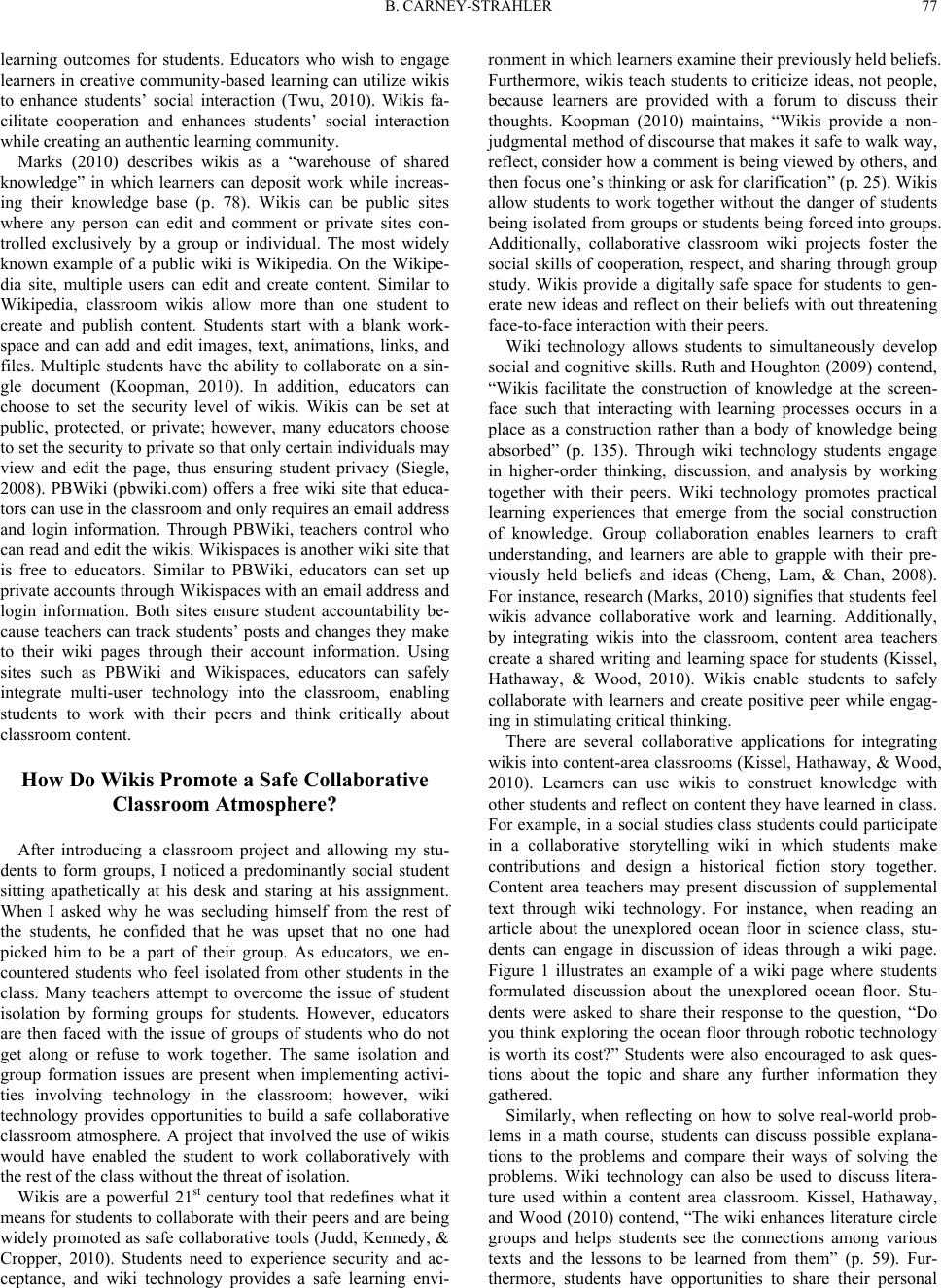 B. CARNEY-STRAHLER 77 learning outcomes for students. Educators who wish to engage learners in creative community-based learning can utilize wikis to enhance students’ social interaction (Twu, 2010). Wikis fa- cilitate cooperation and enhances students’ social interaction while creating an authentic learning community. Marks (2010) describes wikis as a “warehouse of shared knowledge” in which learners can deposit work while increas- ing their knowledge base (p. 78). Wikis can be public sites where any person can edit and comment or private sites con- trolled exclusively by a group or individual. The most widely known example of a public wiki is Wikipedia. On the Wikipe- dia site, multiple users can edit and create content. Similar to Wikipedia, classroom wikis allow more than one student to create and publish content. Students start with a blank work- space and can add and edit images, text, animations, links, and files. Multiple students have the ability to collaborate on a sin- gle document (Koopman, 2010). In addition, educators can choose to set the security level of wikis. Wikis can be set at public, protected, or private; however, many educators choose to set the security to private so that only certain individuals may view and edit the page, thus ensuring student privacy (Siegle, 2008). PBWiki (pbwiki.com) offers a free wiki site that educa- tors can use in the classroom and only requires an email address and login information. Through PBWiki, teachers control who can read and edit the wikis. Wikispaces is another wiki site that is free to educators. Similar to PBWiki, educators can set up private accounts through Wikispaces with an email address and login information. Both sites ensure student accountability be- cause teachers can track students’ posts and changes they make to their wiki pages through their account information. Using sites such as PBWiki and Wikispaces, educators can safely integrate multi-user technology into the classroom, enabling students to work with their peers and think critically about classroom content. How Do Wikis Promote a Safe Collaborative Classroom Atmosphere? After introducing a classroom project and allowing my stu- dents to form groups, I noticed a predominantly social student sitting apathetically at his desk and staring at his assignment. When I asked why he was secluding himself from the rest of the students, he confided that he was upset that no one had picked him to be a part of their group. As educators, we en- countered students who feel isolated from other students in the class. Many teachers attempt to overcome the issue of student isolation by forming groups for students. However, educators are then faced with the issue of groups of students who do not get along or refuse to work together. The same isolation and group formation issues are present when implementing activi- ties involving technology in the classroom; however, wiki technology provides opportunities to build a safe collaborative classroom atmosphere. A project that involved the use of wikis would have enabled the student to work collaboratively with the rest of the class without the threat of isolation. Wikis are a powerful 21st century tool that redefines what it means for students to collaborate with their peers and are being widely promoted as safe collaborative tools (Judd, Kennedy, & Cropper, 2010). Students need to experience security and ac- ceptance, and wiki technology provides a safe learning envi- ronment in which learners examine their previously held beliefs. Furthermore, wikis teach students to criticize ideas, not people, because learners are provided with a forum to discuss their thoughts. Koopman (2010) maintains, “Wikis provide a non- judgmental method of discourse that makes it safe to walk way, reflect, consider how a comment is being viewed by others, and then focus one’s thinking or ask for clarification” (p. 25). Wikis allow students to work together without the danger of students being isolated from groups or students being forced into groups. Additionally, collaborative classroom wiki projects foster the social skills of cooperation, respect, and sharing through group study. Wikis provide a digitally safe space for students to gen- erate new ideas and reflect on their beliefs with out threatening face-to-face interaction with their peers. Wiki technology allows students to simultaneously develop social and cognitive skills. Ruth and Houghton (2009) contend, “Wikis facilitate the construction of knowledge at the screen- face such that interacting with learning processes occurs in a place as a construction rather than a body of knowledge being absorbed” (p. 135). Through wiki technology students engage in higher-order thinking, discussion, and analysis by working together with their peers. Wiki technology promotes practical learning experiences that emerge from the social construction of knowledge. Group collaboration enables learners to craft understanding, and learners are able to grapple with their pre- viously held beliefs and ideas (Cheng, Lam, & Chan, 2008). For instance, research (Marks, 2010) signifies that students feel wikis advance collaborative work and learning. Additionally, by integrating wikis into the classroom, content area teachers create a shared writing and learning space for students (Kissel, Hathaway, & Wood, 2010). Wikis enable students to safely collaborate with learners and create positive peer while engag- ing in stimulating critical thinking. There are several collaborative applications for integrating wikis into content-area classrooms (Kissel, Hathaway, & Wood, 2010). Learners can use wikis to construct knowledge with other students and reflect on content they have learned in class. For example, in a social studies class students could participate in a collaborative storytelling wiki in which students make contributions and design a historical fiction story together. Content area teachers may present discussion of supplemental text through wiki technology. For instance, when reading an article about the unexplored ocean floor in science class, stu- dents can engage in discussion of ideas through a wiki page. Figure 1 illustrates an example of a wiki page where students formulated discussion about the unexplored ocean floor. Stu- dents were asked to share their response to the question, “Do you think exploring the ocean floor through robotic technology is worth its cost?” Students were also encouraged to ask ques- tions about the topic and share any further information they gathered. Similarly, when reflecting on how to solve real-world prob- lems in a math course, students can discuss possible explana- tions to the problems and compare their ways of solving the problems. Wiki technology can also be used to discuss litera- ture used within a content area classroom. Kissel, Hathaway, and Wood (2010) contend, “The wiki enhances literature circle groups and helps students see the connections among various texts and the lessons to be learned from them” (p. 59). Fur- thermore, students have opportunities to share their personal  B. CARNEY-STRAHLER 78 Figure 1. JPEG of a Science Classroom Wiki Page. This figure illustrates what a wiki page us ed in a science classroom th r ough the PBWiki site might look like. work by uploading poetry, stories, and class projects through a student portfolio wiki. How Do Wikis Promote Content Area Literacy? After completing a wiki project on the Bill of Rights, one student told me, “It was cool to see what I know about our rights up on the web site. I didn’t realize the Bill of Rights was so important until we had to think about them and create our web page.” In this project, my students were asked to create wiki pages about each of the ten amendments included in the Bill of Rights. Figure 2 illustrates how my students had to ex- plain the amendments in their own words and develop exam- ples as to why the amendment is still relevant today. Students enjoyed this activity because they were responsible for creating a meaningful and informative web page about the Bill of Rights. Furthermore, my students were able to explain the content material in their own words and reflect on their understandings of content (Knipper & Duggan, 2006). The students did not even realize how critically engaged they were with social studies content. Content teachers understand that in order for students to be successful they must develop literacy skills that can be applied to content area learning. Learners need opportunities to develop cognitive processes by critically evaluating content area mate- rial, rather than rote memorization (Knipper & Duggan, 2006). Wiki technology enables students to demonstrate their learning through a digital space. Learners can use wikis to identify rela- tionships between concepts and make connections to prior knowledge. As students create their wiki pages, they develop their ideas while connecting and integrating new concepts (Johnson & Holcombe, 1993). Wikis help students become better problem solvers and help students understand how to analyze and synthesize information. Furthermore, wiki activi- ties allow students to critically evaluate the world around them because learners are able to expand learning to make meaning of content (Knipper & Duggan, 2006; Peterson, 2007). They can ask each other questions to probe further thinking (Smith, Rook, & Smith, 2007). Wiki technology in the classroom en- bles learners to deepen their thinkin g process. a 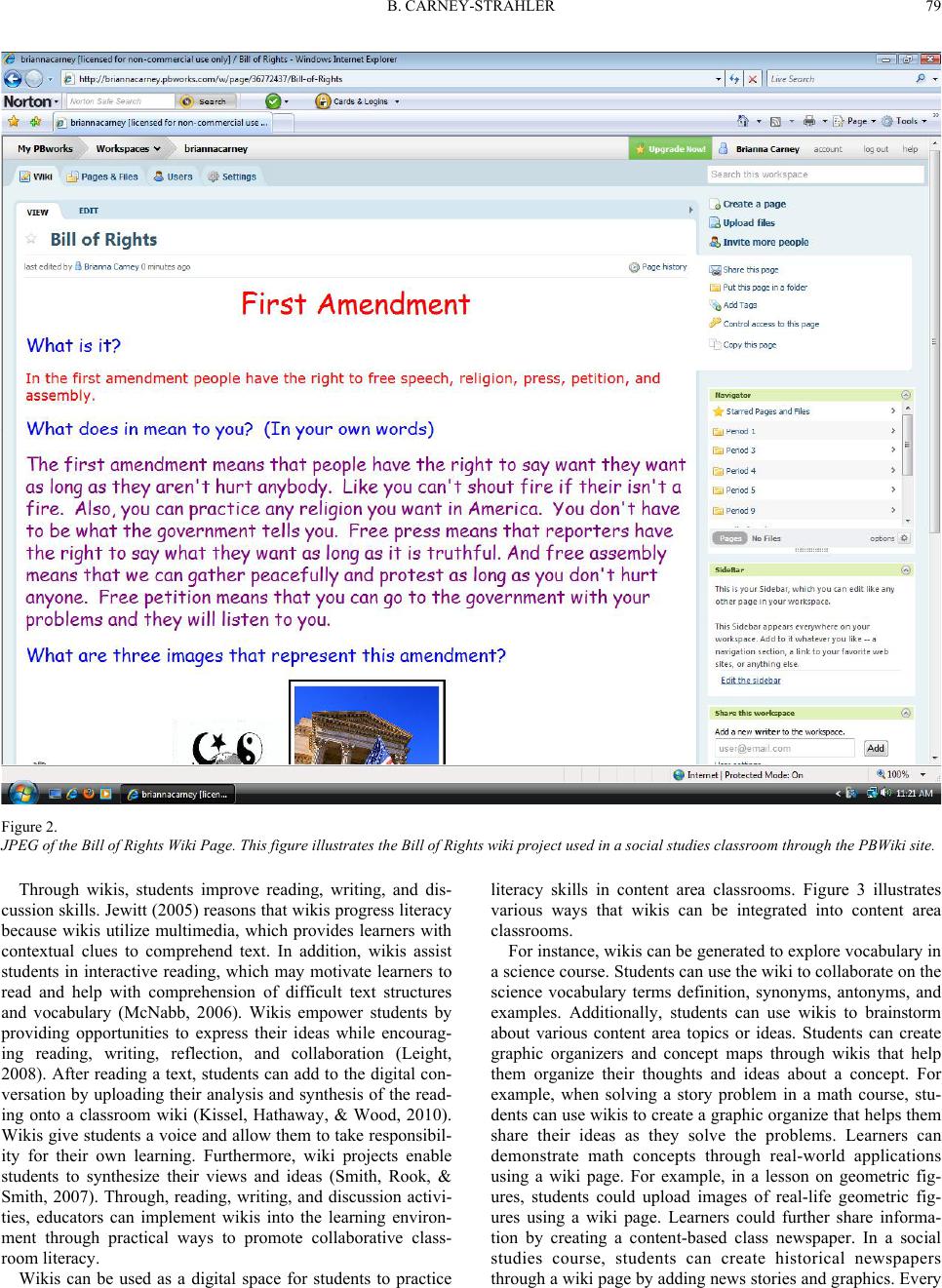 B. CARNEY-STRAHLER 79 Figure 2. JPEG of the Bill of Rights Wiki Page. This figure illustrates the Bill of Rights wiki project used in a social studies classroom through the PBWiki site. Through wikis, students improve reading, writing, and dis- cussion skills. Jewitt (2005) reasons that wikis progress literacy because wikis utilize multimedia, which provides learners with contextual clues to comprehend text. In addition, wikis assist students in interactive reading, which may motivate learners to read and help with comprehension of difficult text structures and vocabulary (McNabb, 2006). Wikis empower students by providing opportunities to express their ideas while encourag- ing reading, writing, reflection, and collaboration (Leight, 2008). After reading a text, students can add to the digital con- versation by uploading their analysis and synthesis of the read- ing onto a classroom wiki (Kissel, Hathaway, & Wood, 2010). Wikis give students a voice and allow them to take responsibil- ity for their own learning. Furthermore, wiki projects enable students to synthesize their views and ideas (Smith, Rook, & Smith, 2007). Through, reading, writing, and discussion activi- ties, educators can implement wikis into the learning environ- ment through practical ways to promote collaborative class- room literacy. Wikis can be used as a digital space for students to practice literacy skills in content area classrooms. Figure 3 illustrates various ways that wikis can be integrated into content area classrooms. For instance, wikis can be generated to explore vocabulary in a science course. Students can use the wiki to collaborate on the science vocabulary terms definition, synonyms, antonyms, and examples. Additionally, students can use wikis to brainstorm about various content area topics or ideas. Students can create graphic organizers and concept maps through wikis that help them organize their thoughts and ideas about a concept. For example, when solving a story problem in a math course, stu- dents can use wikis to create a graphic organize that helps them share their ideas as they solve the problems. Learners can demonstrate math concepts through real-world applications using a wiki page. For example, in a lesson on geometric fig- ures, students could upload images of real-life geometric fig- ures using a wiki page. Learners could further share informa- tion by creating a content-based class newspaper. In a social studies course, students can create historical newspapers through a wiki page by adding news stories and graphics. Every 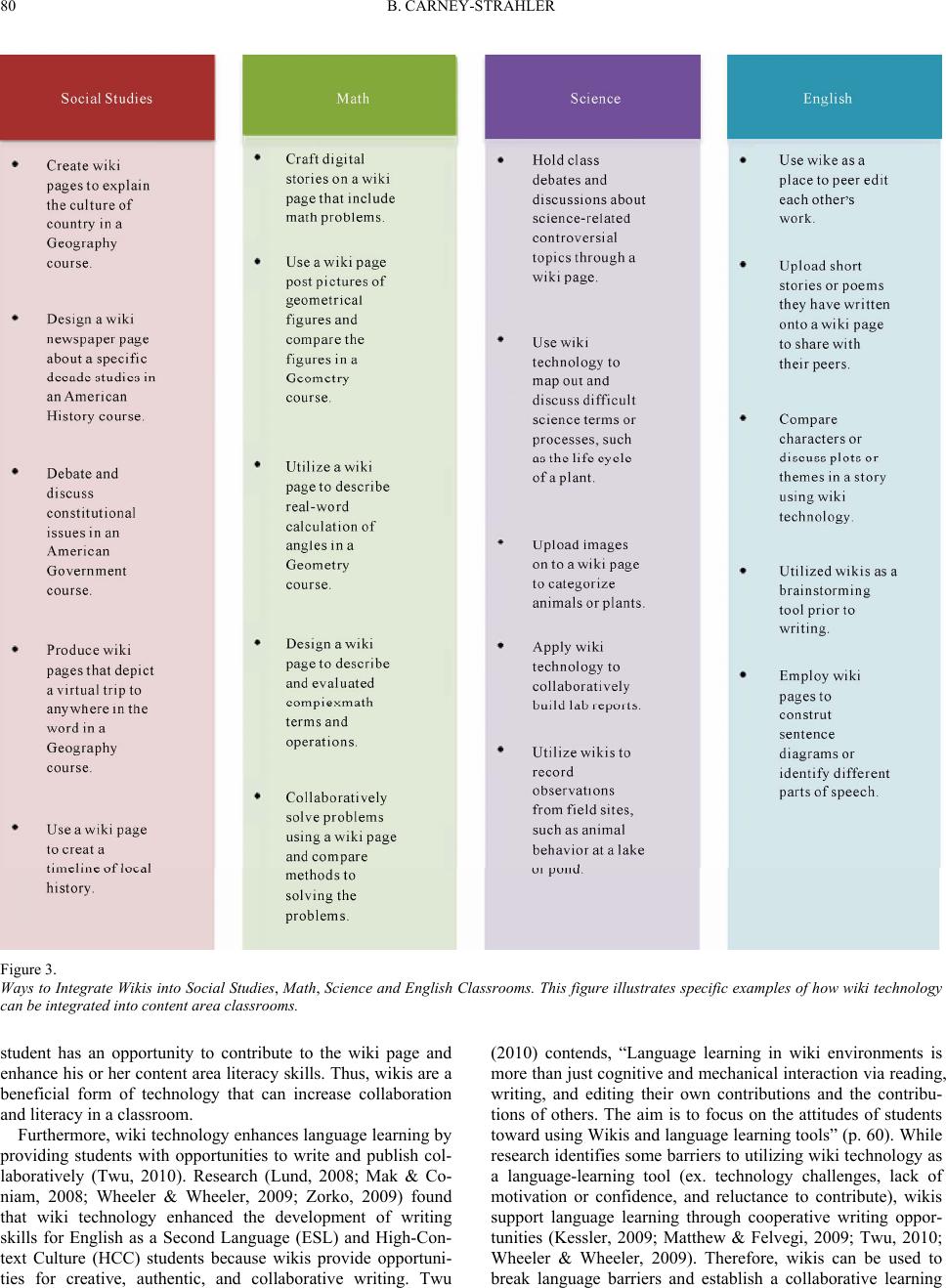 B. CARNEY-STRAHLER 80 Figure 3. Ways to Integrate Wikis into Social Studies, Math, Science and English Classrooms. This figure illustrates specific examples of how wiki technology can be integrated into content area classroo ms. student has an opportunity to contribute to the wiki page and enhance his or her content area literacy skills. Thus, wikis are a beneficial form of technology that can increase collaboration and literacy in a classroom. Furthermore, wiki technology enhances language learning by providing students with opportunities to write and publish col- laboratively (Twu, 2010). Research (Lund, 2008; Mak & Co- niam, 2008; Wheeler & Wheeler, 2009; Zorko, 2009) found that wiki technology enhanced the development of writing skills for English as a Second Language (ESL) and High-Con- text Culture (HCC) students because wikis provide opportuni- ties for creative, authentic, and collaborative writing. Twu (2010) contends, “Language learning in wiki environments is more than just cognitive and mechanical interaction via reading, writing, and editing their own contributions and the contribu- tions of others. The aim is to focus on the attitudes of students toward using Wikis and language learning tools” (p. 60). While research identifies some barriers to utilizing wiki technology as a language-learning tool (ex. technology challenges, lack of motivation or confidence, and reluctance to contribute), wikis support language learning through cooperative writing oppor- tunities (Kessler, 2009; Matthew & Felvegi, 2009; Twu, 2010; Wheeler & Wheeler, 2009). Therefore, wikis can be used to break language barriers and establish a collaborative learning 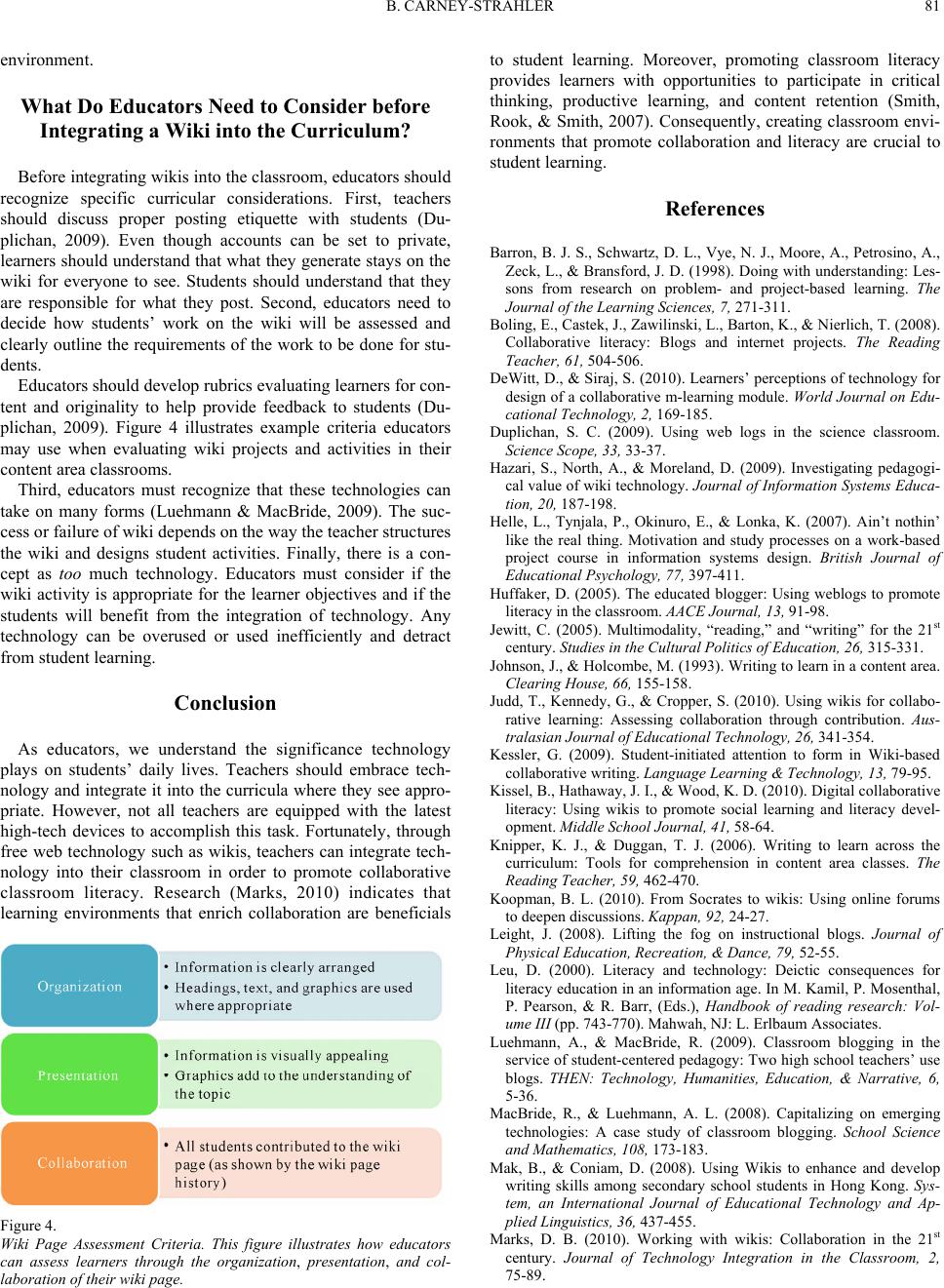 B. CARNEY-STRAHLER 81 environment. What Do Educators Need to Consider before Integrating a Wiki into the Curriculum? Before integrating wikis into the classroom, educators should recognize specific curricular considerations. First, teachers should discuss proper posting etiquette with students (Du- plichan, 2009). Even though accounts can be set to private, learners should understand that what they generate stays on the wiki for everyone to see. Students should understand that they are responsible for what they post. Second, educators need to decide how students’ work on the wiki will be assessed and clearly outline the requirements of the work to be done for stu- dents. Educators should develop rubrics evaluating learners for con- tent and originality to help provide feedback to students (Du- plichan, 2009). Figure 4 illustrates example criteria educators may use when evaluating wiki projects and activities in their content area classrooms. Third, educators must recognize that these technologies can take on many forms (Luehmann & MacBride, 2009). The suc- cess or failure of wiki depends on the way the teacher structures the wiki and designs student activities. Finally, there is a con- cept as too much technology. Educators must consider if the wiki activity is appropriate for the learner objectives and if the students will benefit from the integration of technology. Any technology can be overused or used inefficiently and detract from student learning. Conclusion As educators, we understand the significance technology plays on students’ daily lives. Teachers should embrace tech- nology and integra te it into the curricula where they see appro- priate. However, not all teachers are equipped with the latest high-tech devices to accomplish this task. Fortunately, through free web technology such as wikis, teachers can integrate tech- nology into their classroom in order to promote collaborative classroom literacy. Research (Marks, 2010) indicates that learning environments that enrich collaboration are beneficials Figure 4. Wiki Page Assessment Criteria. This figure illustrates how educators can assess learners through the organization, presentation, and col- laboration of their wiki p ag e . to student learning. Moreover, promoting classroom literacy provides learners with opportunities to participate in critical thinking, productive learning, and content retention (Smith, Rook, & Smith, 2007). Consequently, creating classroom envi- ronments that promote collaboration and literacy are crucial to student learning. References Barron, B. J. S., S chwartz, D. L., Vye, N. J., Moo re, A., Petrosino, A., Zeck, L., & Bransford, J. D. (1998). Doing with understanding: Les- sons from research on problem- and project-based learning. The Journal of the Learning Sciences, 7, 271-311. Boling, E., Castek, J., Zawilinski, L., Barton, K., & Nierlich, T. (2008). Collaborative literacy: Blogs and internet projects. The Reading Teacher, 61, 504-506. DeWitt, D., & Siraj, S. (2010). Learners’ perceptions of technology for design of a collaborative m-learning module. World Journal on Edu- cational Technolo gy, 2, 169-185. Duplichan, S. C. (2009). Using web logs in the science classroom. Science Scope, 33, 33-37. Hazari, S., North, A., & Moreland, D. (2009). Investigating pedagogi- cal value of wiki technology. Journal of Information Systems Educa- tion, 20, 187-198. Helle, L., Tynjala, P., Okinuro, E., & Lonka, K. (2007). Ain’t nothin’ like the real thing. Motivation and study processes on a work-based project course in information systems design. British Journal of Educational Psychology , 77, 397-411. Huffaker, D. (2005). The educated blogger: Using weblogs to promote literacy in the classroom. AACE Journal, 13, 91-98. Jewitt, C. (2005). Multimodality, “reading,” and “writing” for the 21st century. Studies in the Cultural P olitics of Education, 26, 315-331. Johnson, J., & Holcombe, M. (1993). Writing to learn in a content area. Clearing House, 66, 155-158. Judd, T., Kennedy, G., & Cropper, S. (2010). Using wikis for collabo- rative learning: Assessing collaboration through contribution. Aus- tralasian Journal of Educational Technology, 2 6 , 341-354. Kessler, G. (2009). Student-initiated attention to form in Wiki-based collaborative writing. Language Learning & Technology, 13, 79-95. Kissel, B., Hathaway, J. I., & Wood, K. D. (2010). Digital collaborative literacy: Using wikis to promote social learning and literacy devel- opment. Middle Sc ho ol J ou rnal, 41, 58-64. Knipper, K. J., & Duggan, T. J. (2006). Writing to learn across the curriculum: Tools for comprehension in content area classes. The Reading Teacher, 59, 462-470. Koopman, B. L. (2010). From Socrates to wikis: Using online forums to deepen discussions. Kappan, 92, 2 4-27. Leight, J. (2008). Lifting the fog on instructional blogs. Journal of Physical Education, Recreation, & Dance, 79, 52-55. Leu, D. (2000). Literacy and technology: Deictic consequences for literacy education in an information age. In M. Kamil, P. Mosenthal, P. Pearson, & R. Barr, (Eds.), Handbook of reading research: Vol- ume III (pp. 743-770). Mahwah, NJ: L. Erlbaum Associate s. Luehmann, A., & MacBride, R. (2009). Classroom blogging in the service of student-centered pedagogy: Two high school teachers’ use blogs. THEN: Technology, Humanities, Education, & Narrative, 6, 5-36. MacBride, R., & Luehmann, A. L. (2008). Capitalizing on emerging technologies: A case study of classroom blogging. School Science and Mathematics, 108, 173- 183. Mak, B., & Coniam, D. (2008). Using Wikis to enhance and develop writing skills among secondary school students in Hong Kong. Sys- tem, an International Journal of Educational Technology and Ap- plied Linguistics, 36, 437-455. Marks, D. B. (2010). Working with wikis: Collaboration in the 21st century. Journal of Technology Integration in the Classroom, 2, 75-89.  B. CARNEY-STRAHLER 82 McNabb, M. (2006). Navigating the maze of hypertext. Educational Leadership, 63, 76-79. Olliges, R. (2010). Wikis and collaboration: Are they a mix? Journal of Philosophy and History Ed u c at i on , 60, 77-80. Paus-Hasebrin, I., Wijnen, C. W., & Jadin, T. (2010). Opportunities of Web 2.0: Potentials of learning. International Journal of Media and Cultural Politics, 6, 45-62. Peterson, S. S. (2007). Teaching content with the help of writing across the curriculum. Middle School Journal, 39, 26-33. Ruth, A., & Houghton, L. (2009). The wiki way of learning. Austral- asian Journal of Educational Technology, 25, 135-152. Siegle, D. (2008). W orking with wikis. Gifted Chi ld Today, 31, 14-17. Smith, K. S., Rook, J. E., & Smith, T. W. (2007). Increasing student engagement using effective and metacognitive writing strategies in content areas. Preventing School Failure, 51 , 43-48. Twu, H. (2010). A predictive study of wiki interaction: Can attitude toward Wikis predict wiki interaction in high-context cultures groups? Journal of Educational Technology Development and Exchange, 3, 57-68. Wheeler, S., & Wheeler, D. (2009). Using wikis to promote quality learning in teacher training. Learning, Media, and Technology, 34, 1-10. Zorko, B. (2009). Factors affecting the way students collaborate in a Wiki for English language learning. Australasian Society for Com- puters in Learning in Tertiar y Education, 25, 645-655. |

